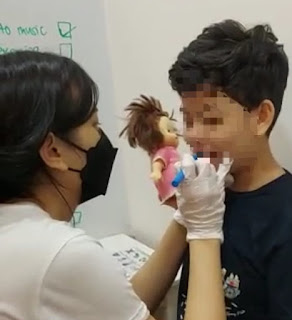DOING THE SAME THINGS DIFFERENT! (Don't Give Up Mummy - Continued)
In this entry, I will share with you why the therapy approaches mentioned in my previous post 'Don't Give Up Mummy!' did not work for YS.
HanenTM Approach
I personally love and use a lot of the HanenTM Approach. However, it takes quite a bit of effort to follow through and apply it accurately and consistently into the child's daily routine, especially after the 8-week HanenTM course has finished and we continue in the business of our daily lives. It takes much effort for us to be mindful of the communication opportunities throughout the day. My favourite homework for parents is to list down all the activities in the child's routine and then look at the opportunities in each activity. It helps us to be mindful of the child and how we can be 'in the present' with them throughout the day.
Looking at the above, I am going to 'Do the Same Thing Different' for YS!
--------------------------------------------------------------------------------------------------------------------------
For additional information:
Tools Commonly Prescribed for Oromotor Exercises
http://www.talktools.com/therapy-essentials/
http://www.arktherapeutic.com/oral-motor/
The PROMPT Approach - Analysing the level of breakdown of the speech system
http://promptinstitute.com/index.php?page=what-is-prompt3
NDT Approach - Looking at the whole body while working on speech
https://www.ndta.org/
Picture Exchange Communication System (PECS)
http://www.pecsusa.com/pecs.php
The Hanen Approach - Useful articles for parents
http://www.hanen.org/Helpful-Info.aspx
Oromotor Exercises:
Often, oromotor exercises with therapy tools have been prescribed to children without a good understanding of the child's difficulties which led to speech problems. There have been quite a lot of commercialized tools that come with thick manuals, instructing us how to use those tools step-by-step for 'speech development'. I love using these tools and they have been very effective in my therapy. However, there is no manual which teaches us how to diagnose each child's difficulty, nor is there a manual which teach us how to transit the oromotor skills to speech. We need professional knowledge and clinical judgement to tease out the specific cause of a child's speech problem and how to transit the oromotor skills to speech. For speech, we have to look at jaw stability, lip dissociation and tongue dissociation. We need to find out the level at which breakdown happens, so that our oromotor exercises can target the specific problem. We also have to keep in mind the link between an oromotor skill and a specific speech sound. Personally, I adjunctly use both PROMPT and NDT approaches when prescribing oromotor exercises (refer to links below for more information of PROMPT and NDT).
Picture Communication System (PCS):
(including PECS, Picture Exchange Communication System)
(including PECS, Picture Exchange Communication System)
PCS can be prescribed as an alternative or augmentative communication. Many times, PCS are prescribed to REPLACE speech (what we called Alternative Communication). However, for children who have potential for speech, PCS should be used to SUPPORT, not replace, speech (what we called Augmentative Communication). When YS was prescribed with PCS, the emphasis should be getting her to use her speech alongside the pictures. For example, when she wants biscuits and points to a picture of biscuits, she should be expected to say 'biscuits' before it is given to her. The pictures will support her speech, not replace it. The lack of expectation for YS to use her speech alongside the PCS could be what caused her to stop talking and over-rely on pictures. Her needs had been met just by pointing to the respective pictures, without having to say anything.
HanenTM Approach
I personally love and use a lot of the HanenTM Approach. However, it takes quite a bit of effort to follow through and apply it accurately and consistently into the child's daily routine, especially after the 8-week HanenTM course has finished and we continue in the business of our daily lives. It takes much effort for us to be mindful of the communication opportunities throughout the day. My favourite homework for parents is to list down all the activities in the child's routine and then look at the opportunities in each activity. It helps us to be mindful of the child and how we can be 'in the present' with them throughout the day.
Looking at the above, I am going to 'Do the Same Thing Different' for YS!
--------------------------------------------------------------------------------------------------------------------------
For additional information:
Tools Commonly Prescribed for Oromotor Exercises
http://www.talktools.com/therapy-essentials/
http://www.arktherapeutic.com/oral-motor/
The PROMPT Approach - Analysing the level of breakdown of the speech system
http://promptinstitute.com/index.php?page=what-is-prompt3
NDT Approach - Looking at the whole body while working on speech
https://www.ndta.org/
Picture Exchange Communication System (PECS)
http://www.pecsusa.com/pecs.php
The Hanen Approach - Useful articles for parents
http://www.hanen.org/Helpful-Info.aspx



Comments
Post a Comment